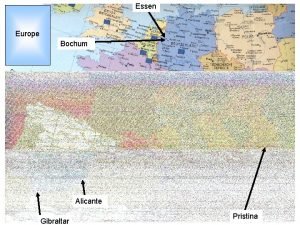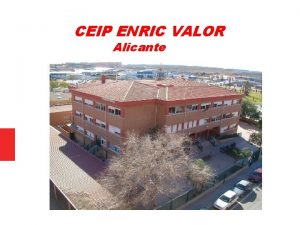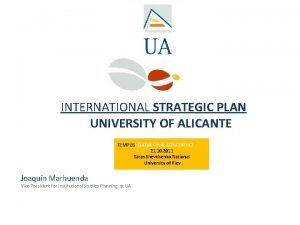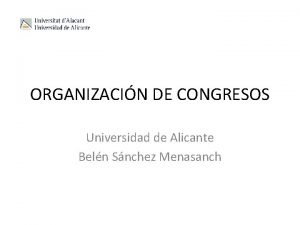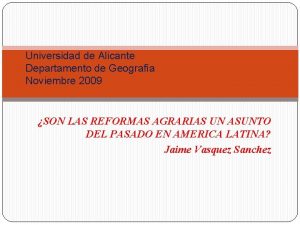Ecoarchitecture 2016 Alicante from 13 to 15 July














- Slides: 14

Eco-architecture 2016, Alicante, from 13 to 15 July 2016 Bioclimatism in Architecture: an evolutionary perspective Anh Tuan NGUYEN 1 Sigrid REITER 2 1 Faculty of Architecture, The University of Danang – University of Science and Technology, Vietnam 2 LEMA (Local Environment Management and Analysis), Faculty of Applied Sciences, University of Liège, Belgium Sigrid Reiter 1

Introduction Natural selection as the most important mechanism of evolutionary processes at every level (from biological systems, including species, individual organisms… to molecules such as DNA or proteins). Visual representation of the history of life on Earth as a spiral (Graham et al. 2008) Sigrid Reiter 2

Aim and methodology Ø Aim to clarify the evolution process of the bioclimatic approach in architecture Ø Methodology = theoretical research method (based on analysis of history of architecture, observation and comparison of processes and events) Ø Main issues: Ø Explaining the development of architectural concepts by applying the idea of the evolutionary theory through a natural evolutionary perspective. Ø Clarifying present challenges of current architecture facing climate change so as to give predictions of the trend of bioclimatic architectural evolution. Sigrid Reiter 3

Results 1/ similarities between the process of the natural evolution and the process of the evolution of architecture Sigrid Reiter 4

Results Sigrid Reiter 5

Results 2/ Evolutionary process of the bioclimatic approach in architecture : Sigrid Reiter 6

Results Bioclimatic architecture Passive and low energy architecture Passive design solutions adapt to climatic conditions to create indoor comfort, satisfying better demands of building occupants. Employing advanced design techniques to build more energy efficient and more comfortable buildings. This trend has partly evolved towards creating zero-energy buildings. Green buildings Buildings respectful for their natural environment and strictly controlling their environmental impacts through the building’s entire lifecycle, while maintaining good indoor comfort for occupants. Sustainable architecture Meeting the needs of present generations without compromising the ability of future generations to meet their needs while balancing environmental, social and economic issues in the building design. Sigrid Reiter 7

Results Sigrid Reiter 8

Results Evolutionary theory as a method in building design (Dieterle, F. 2003) Sigrid Reiter 9

Results Redefining the bioclimatic approach: challenges emerging from climate change Ø Relying on the evolutionary theory, climate change is seen has a driving force of future architectural evolutions. The bioclimatic architecture (adapted from Olgyay 1963) Sigrid Reiter 10

Results Ecological architecture and green buildings refer to environmentally responsible buildings that are eco-friendly, resources-efficient and low producer of environmental impacts throughout the building’s life-cycle. Sigrid Reiter 11

Results a new approach in architecture - the “Eco-adaptive approach”- as a new evolutionary step of the conventional “Bioclimatic approach”. Sigrid Reiter 12

Conclusion This paper proposes a new perspective of the development of bioclimatic architecture: the perspective of his natural evolution. We can apply evolutionary theory to explain the formation and extinction of some architectural movements. Through a comparative analysis and synthesis, this study has highlighted the perspective of the evolution of bioclimatic architecture over time. The study also showed that theory of natural evolution has a certain role in the development of innovative bioclimatic design methods which allow designers to create greener buildings. In recent years, rapid climate change has become a new driving force for the architectural evolution. Finally, this paper proposes the “Eco-adaptive approach” as the next evolutionary step towards a more sustainable architecture thanks to its resilience and its ability to adapt to changes in its environment. The research approach as well as the comparative analysis in this study could be the catalyst for further studies, and also generate helpful materials for teaching and learning architecture at school. Sigrid Reiter 13

Eco-architecture 2016, Alicante, from 13 to 15 July 2016 Thank you! Contact: : sigrid. reiter@ulg. ac. be Publications : http: //orbi. ulg. ac. be/ Sigrid Reiter 14
 Ies pacheco alicante
Ies pacheco alicante Comarcas de la provincia de alicante
Comarcas de la provincia de alicante Educamos alicante
Educamos alicante Club de regatas alicante
Club de regatas alicante Alicante gibraltar
Alicante gibraltar Dmi alicante
Dmi alicante Ceip enric valor alicante
Ceip enric valor alicante Pantanos alicante
Pantanos alicante Plan reviu alicante
Plan reviu alicante July 26 1953
July 26 1953 July 12 1776
July 12 1776 June too soon july stand by
June too soon july stand by Harris burdick uninvited guest
Harris burdick uninvited guest Gdje se rodio nikola tesla
Gdje se rodio nikola tesla 2003 july 17
2003 july 17




